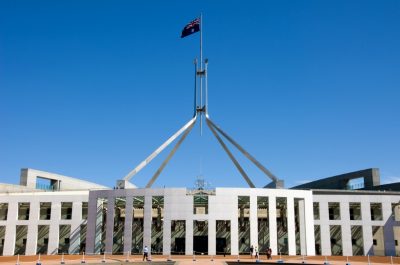Who’s the boss? Why energy security could depend on new market oversight

The $265 million energy security plan unveiled last week as part of the federal budget confirmed the Government’s plans to invest in energy generation. State governments are also intervening in the National Electricity Market (NEM) in an attempt to keep the lights on. Does energy security depend on government investment? Should the market be left to its own devices? Or do we need a new way of governing the NEM?
Budget measures to address a ‘crisis’
Treasurer Scott Morrison’s budget speech announced measures for the Australian Government’s $265 million energy security plan, aimed at providing Australians with reliable and affordable electricity. The range of measures proposed in the federal budget included, among other measures, funding for studies of new gas pipeline interconnectors.to South Australia, agreed after a previous political compromise with the Nick Xenophon Team. .The Government also backed in its plans for the Snowy 2.0 “game changer” announced by the Prime Minister in March, with plans to increase its shareholding in Snowy Hydro or to pay for a full takeover from New South Wales and Victorian Governments. The Government also affirmed its commitment for Snowy Hydro to remain in public hands.
Budget measures also included potential investment of up to $110 million in a Port Augusta concentrated solar thermal project, if required.
State governments are also constructing their own interventions in the NEM. The South Australian Government’s Energy Plan includes investment in the market and legislation to give itself new powers to direct generators to operate in the market and direct the Australian Energy Market Operator (AEMO) to control flow on the interconnector. Last month, the Federal and Tasmanian Governments announced the expansion of Tasmanian Hydro System that it claims could deliver up to 2,500MW of storage capacity for the NEM. In Victoria, the Andrews Government claimed it was, “…taking the action required to ensure reliable and affordable energy supply for Victorians while we deliver on our renewable energy targets”. It called for expressions of interest for a 20MW battery to be constructed in the north-west or south-west of Victoria.
Gaps in the market?
These interventions are a response to a ground swell of opinion that Australia is in crisis when it comes to energy. Many sectors blame governments at both levels. In the recently aired 4 Corners program, AiG’s Innes Wilcox claimed there has been a “catastrophic failure of national policy making and a catastrophic failure of the national energy market….our political masters either have been unable to or unwilling to address.”
Where there is a lack of confidence in the market that State and Federal governments worked hard to establish, there will be pressure to fill the gap with more direct intervention. But at least one key institution warns government intervention is exacerbating the problem. In its recent review of drivers of transmission investment, the Australian Energy Market Commission (AEMC) concluded that intervention does little to provide confidence to the market – in fact it is likely to undermine more market driven transmission and generation investment.
Last month, AGL Chief Executive Andy Vesey commented “you could hear the sound of shredding paper “as AGL advised it had put investment plans on ice in South Australia following the Weatherill Government’s decision to build generation in the state.
This week, Electranet executives told a South Australian Parliamentary Inquiry that, while some elements of the government intervention would be likely to ease power prices:
Can’t this be solved with existing institutions?
Many argue that the ability to address the crisis already exists in market institution functions. Arguably, existing institutions, including the AEMC Reliability Panel and Australian Energy Market Operator (AEMO), have had the statutory ability to actively intervene to address NEM security risks[2]. For instance current reviews of NEM system security by the AEMC have proposed new frameworks to deliver inertia services, fast frequency response and other frequency services.
However the existing governance and institution framework seems ill-equipped for more immediate action to address market weaknesses. The preliminary report of the Finkel Review alludes to this, noting that (p47) “the division of responsibilities between the institutions means no single entity provides a ‘whole-of-system’ perspective and advice to ministers, officials or the general public”. This is partly due to the intentional design of Australia’s framework for national energy markets which:
- encourages a primary reliance on market based responses for energy security within the broad parameters specified in Reliability Standard & Settings (Market Price Cap, etc);
- emphasises market information sources (such as the NEM SOO, GSOO, NTNDP, etc) while deemphasising intervention (eg. relying on Emergency Reserve Trader, Last Resort Planner, etc); and,
- maintains significant responsibilities with State jurisdictions (e.g. reliability, technical regulation and licensing functions), thereby relying on inter-jurisdictional coordination to achieve overall outcomes.
Governance matters
Each of the three institutions, the AEMC, the AER and AEMO, individually play key roles in ensuring safe, reliable and affordable energy across the NEM. However as the Finkel review notes, Australia seems to lack coordination in governance, particularly during a sustained period of dynamic change in the market.
Without a clear institutional capability to address energy security and provide confidence to State and Federal governments, the risks of ad hoc, unilateral intervention are likely to remain high.
If the Finkel Panel concludes that there is a problem, what must an alternative governance model for energy security deliver? It is likely to require not only the coordination of market institution functions, but also an independent ability to intervene including on matters of market design and rule changes. This would necessarily require independence from existing market institutions.
The North American model
The North American Electric Reliability Corporation (NERC), established in 1968, was given statutory powers following the 2003 East Coast Blackout, when the subsequent investigation found that the voluntary regime had been ineffective. Among other things, the Joint US-Canada investigation found that:
“Although NERC’s provisions address many of the factors and practices which contributed to the blackout, some of the policies or guidelines are inexact, non-specific, or lacking in detail, allowing divergent interpretations among reliability councils, control areas, and reliability coordinators. NERC standards are minimum requirements that may be made more stringent if appropriate by regional or subregional bodies, but the regions have varied in their willingness to implement exacting reliability standards.
“NERC and the industry’s reliability community were aware of the lack of specificity and detail in some standards, including definitions of Operating Security Limits, definition of planned outages, and delegation of Reliability Coordinator functions to control areas, but they moved slowly to address these problems effectively.” (Emphasis added)
NERC’s effectiveness stems from its single minded focus on security. Today, NERC develops, implements, and enforces mandatory Reliability Standards for the bulk power system in accordance with Section 215 of the Federal Power Act. The statute requires that all users, owners, and operators of the bulk power system in the United States be subject to approved Reliability Standards.
NERC Reliability Standards cover the design, planning, and operation of the bulk power system, as well as cyber and physical security. In addition, NERC serves as the Electricity Information Sharing and Analysis Center (E-ISAC). The E-ISAC gathers and analyses security information, coordinates incident management, and communicates mitigation strategies with stakeholders within the Electricity Subsector, across interdependent sectors, and with government partners. It contributes the primary security communications channel for the Electricity Subsector enhancing its ability to prepare for and respond to cyber and physical threats, vulnerabilities, and incidents.
NERC also assesses electricity supply adequacy annually via a 10-year forecast; special and seasonal assessments; monitors the bulk power system; and educates, trains, and certifies industry personnel. NERC assesses and reports on the reliability and adequacy of the North American bulk power system.
NERC draws on power industry experts from across the industry but retains its own capabilities including about 180 staff, to allow independent analysis[3].
Applying this to an Australian context, one may see parallels between the role of NERC and an expanded role for the AEMC’s Reliability Panel. The expanded role could extend to a more acute focus on achieving the required level of overall energy system security, including power system security in the NEM in the current rapidly changing external environment. An expanded Reliability Panel would need to consider its own governance structure, resourcing, planning and last resort intervention capabilities.
Based on recent decisions, however, more substantive changes may be required to provide confidence to State and Federal governments and reduce the risk of ad hoc, unilateral intervention. This may require a newly formed body with the capacity to intervene to address energy security. A forum for coordination of market institution functions as well as an independent ability to intervene including on matters of market design and rule changes, may require independence from all existing market institutions.
Whatever recommendations the Finkel Panel might make to the COAG Energy Council, its most significant conclusions are likely to be the hardest for the Council itself to hear. More than two years after the Vertigan Review began, energy market governance in Australia’s federal system remains in a mess.
As Ausnet Chief Executive and Chair of Energy Networks Australia told investors recently, the Finkel Review presents a “once in a generation opportunity” for long-term reform.
“Governments must provide an instructive template rather than conflicting interventions….Continued partisan politics will only exacerbate the very real issues the sector and community are facing.’’[4]
[1] Rainer Korte, Executive Manager of Asset Management, quoted in “SA power: Interconnector push undermined by state’s energy plan, ElectraNet says”, ABC News.
[2] AEMO has responsibility under section 49 (1) (e) of the National Electricity Law “to maintain and improve power system security.” The Reliability Panel also has ”periodic and ongoing obligations under the NER to review market parameters regarding power system security and reliability”. For instance, it has had the capacity to review Performance Standards in the face of changing system security conditions.
[3] See the NERC Roster of Committee Participants and Staff available at http://www.nerc.com/AboutNERC/Resource%20Documents/roster.pdf
[4] Quoted in The Australian, “Partisan politics ruins energy policy: AusNet” 17 May 2017, p. 22

